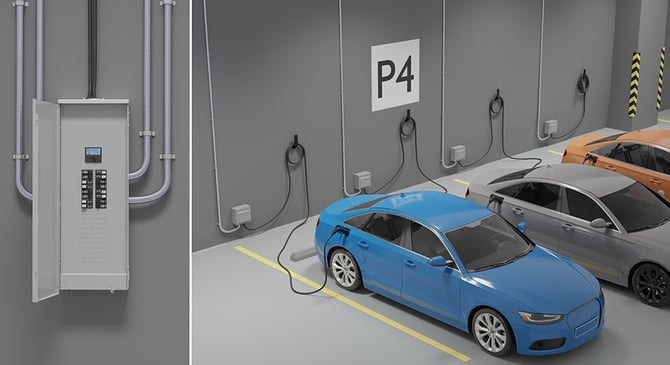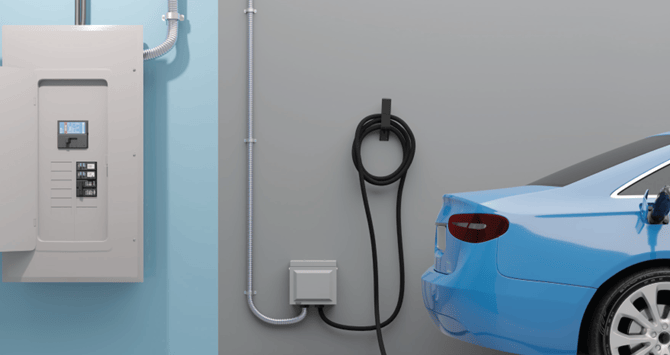
Are Owners Fighting Over EV Chargers?
Are EV chargers becoming a point of contention in residential buildings?
STRATAS


Why do some residential buildings only have a few EV Chargers?
In 2014, the City of Vancouver began discussions about changing the bylaws to require newly built residential buildings to have a certain number of parking stalls equipped with EV charging. By 2018, they mandated that new Multi Unit Residential Buildings must have 20% of their parking stalls built with EV chargers. In 2019, they further tightened the regulations, requiring that all newly built MURB's be 100% EV Ready, with an EV charger in every parking stall.
Introduction
Changes to rules and regulations are usually implemented in stages. This makes it a smoother process rather than changing everything all at once. Today in 2024 all new residential buildings must be 100% EV Ready, with EV chargers in every stall. However, this didn't happen overnight. As mentioned, in 2018 the rules only required 20% of parking stalls to be EV Ready. This means there's a large number of new buildings out there that are under equipped with EV charging. You can imagine the problems that arise between residents who were expecting every owner to have their own dedicated EV charger.
The Problem
This poses a big problem for the buildings built just before 2019. Buildings that were only built with 20% of the parking stalls EV Ready - which residents get those stalls? Are they allocated to the residents who have electric vehicles? Or is it just the luck of the draw?
What Does EV Ready Mean?
This is a good question. An "EV Ready" stall means that the parking stall is equipped with all the necessary electrical wiring to support EV charging. In technical terms, it means that a conduit has been run from a panel in the electrical room to a junction box in the stall. Sometimes there's an outlet in the stall for the charger to plug into. More often, a junction box is placed in the stall so the charger can be hardwired in when the owner is ready.
Luck of the Draw
Yesterday, I visited a building constructed in 2018. The building has approximately 80 parking stalls, but only 15 are equipped with EV chargers. These stalls are lined up nearest to the electrical room. When I asked about the number of EV's in the building, the manager said, "There are nearly 10 EV's, and the drivers are all fighting for the EV stalls and trying to negotiate trades with each other."
As you can imagine, this can be a point of contention amongst residents that live in the building. When someone with an electric vehicle needs to use an EV Charger and sees one in a parking stall occupied by a non-electric vehicle, resentment can start to build.
Gas Cars in EV Spots
It appears that most of the EV charging stalls are allocated to owners who don't even own electric vehicles. Their gas-powered cars occupy these spaces, but they refuse to exchange stalls, claiming they might drive an EV soon. However, I suspect the underlying reason they aren’t willing to trade stalls is that owning an apartment with an EV Rady parking stall significantly increases their property value.
Who Gets the Charging Stalls?
This comes down to lowest cost and easiest install for developers. Developers typically prefer a process that is as straightforward as possible. They usually choose a group of consecutive parking stalls that are beside each other closest to the electrical room. One could argue that they should conduct a survey to determine which owners have electric vehicles, but this is not always feasible. When these buildings were constructed, not all units were pre-sold, making it nearly impossible to determine who has an EV prior to the residents moving in.
Value of Unit
Owners that were fortunate enough to be given an EV Ready stall also received a bump in their property value. This is especially true if there is a high demand for EV charging in the building. The resale value of their property increases, as this is an additional amenity they can list with their property. With electric vehicle sales rising by 20% each quarter, condos with parking stalls that have their own dedicated EV chargers will become even more valuable with time.
Monthly Fee for Electricity
Remember, electricity isn't free. It would be unfair if some residents were charging their electric vehicles at the expense of others. To solve this, most strata councils have implemented a monthly charging fee for using the building's electricity. The monthly fee varies, but for this building, it was $40 a month to use an EV charger in your parking space.
Developers
Installing EV Chargers can be expensive and complex due to the substantial electrical work required. Building developers are aware of this. I suspect that many developers anticipated the increased cost associated with the 2019 regulation change requiring buildings to be 100% EV Ready. To circumvent this requirement, they likely submitted their building permits to the city earlier than necessary for upcoming projects. This would allow them to get approval for the project with only 20% EV Ready stalls and postpone construction until they were ready to start building. This is purely speculation, but it may explain why many recently completed buildings I've visited are only 20% EV Ready even though they were finished well after the 2019 rule change.
Chargers Not Included
When the building is constructed, developers often do not include and supply the physical chargers. Instead, the stalls are equipped and wired for electric vehicles, with a conduit and outlet. However, the installation and payment of the charger is typically the responsibility of the owners. The owner can choose which make and model of EV charger they would like to purchase as well as the software provider to monitor the unit.
Conclusion
In conclusion, the transition to electric vehicles is an inevitable part of our future. However, the challenges faced by strata buildings in making this shift are creating tension amongst residents. With inconsistency in the availability of EV Ready stalls and the increasing demand for them, there is a growing sense of frustration and resentment.
Additionally, the increased property value that comes with an EV Ready stall is giving rise to opportunistic behaviours. The solution to this issue is not straightforward, as it involves costs, convenience, and fairness. Ideally, every resident will have access to an EV Ready stall in the future. Until then, strata buildings, residents, and developers will need to find a way to navigate these issues in a manner that is fair and forward-thinking. Until then, remember cooler heads prevail and everything will work out with enough time.
As always, I’m here if you have questions or comments. Feel free to reach out if anything comes to mind.
Until next time,
Strong Energy








